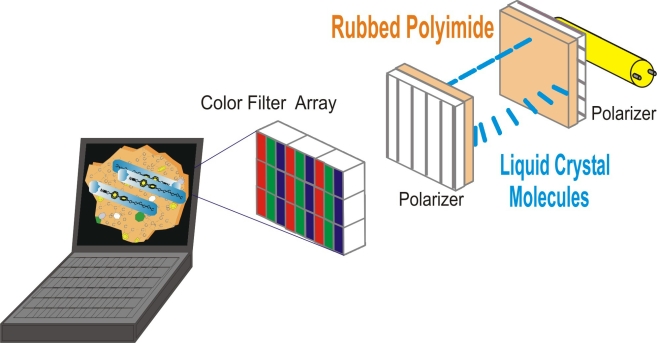Home »
Computer Graphics
Flat Panel Display in Computer Graphics
Computer Graphics | Flat Panel Display: In this tutorial, we are going to learn about the Flat Panel Display, how the image is projected on a flat panel, and how the system works to handle the display?
By Monika Sharma Last updated : April 05, 2024
Flat Panel Display
It is generally known as FPD, the flat-panel display is such a display technology which overtakes Cathode Ray Tube as a new standard of computer desktop displays. Unlike monitors through CRT, flat-panel displays use LCD (liquid crystal display) or LED (light-emitting diode) screens, which makes them lighter and thinner as compared to the previous monitors.

Image source: https://www-ssrl.slac.stanford.edu/stohr/liquidcrystal.htm
These refer to the class of video devices that have resulted in the reduction of weight, size, and consumption of energy as compared to the Cathode Ray Tube. They are mainly used in televisions, monitors and various other sources.
These are basically and broadly divided into two categories which are,
- Emissive Displays: These are devices that work based on the conversion of electrical energy into light energy. Some of its applications include an electroluminescent display, Light Emitting Diode (LED), panels made by plasma and many more. The image is directly produced on the screen.
- Non-emissive Displays: These type of devices use optical effects which converts sunlight or lights from other sources into some graphical patterns that are displayed on the screen. These have applications in LCD etc. Light is produced behind the screen and the image is formed by the filtration of this light.
Types of Flat Panel Display
There are various types of flat panel displays and options of those available. The major three types of flat panel displays available which are included in the market also are,
1. LCD
Liquid Crystal Display. These displays have proved to be the most widely used type of display for long until recent times. This is a method of lighting through the backside which uses a panel of CFL lamps that are placed behind the two panels of glass which is filled with a liquid crystal matter, which gets opaque when an electric current passes through it. This contrast produced between the opaque and the transparent areas available forms of visible characters. These LCDs are less expensive, wider and weigh comparatively more than the LED displays.

2. LED
Light Emitting Diode. The concept of LED is generally the same as CFL backlighting, the basic differences in their performances are still significant. LEDs can be more quickly switched on and switched off than the CFL displays, and they can offer a typical brighter screen. Their displays are sharper, clearer and produce brighter colors and better than LCD. LEDs give a slimmer profile, with some basic commercial displays being less than even a few millimeters in depth where LCDs are up to 5-inch display. Because of thee so many advantages and also leads to the saving of energy, manufacturers have ultimately and gradually decided to discontinue the CFL displays.

3. OLED
The organic light-emitting diode (OLED) is referred to as the organic LED, which is similar to a regular LED, except the fact that it is made up of semiconductor material which is organic. This organic material is placed between the two electrodes, and it emits light when a flow of current is made to pass through the entire volume. This active material is comparatively thinner than a regular LED. The users can expect various new and unique display technologies that use OLED for these retail applications.

Advantages of Flat Panel Display
- Flat Panel Devices such as LCD produce high-quality digital images. The images produced with the help of these devices is of great quality with high resolution.
- Flat Panel monitors are very stylish and they have a very space-saving design. The space consumed by the other type of devices is comparatively more than these.
- Flat Panel Devices also consume comparatively less power and give out the maximum size of the image takes in minimum space.
- Flat Panel Device uses its capability of full-color display.
- Full motion videos can also be viewed on Flat Panel Devices.
Advertisement
Advertisement